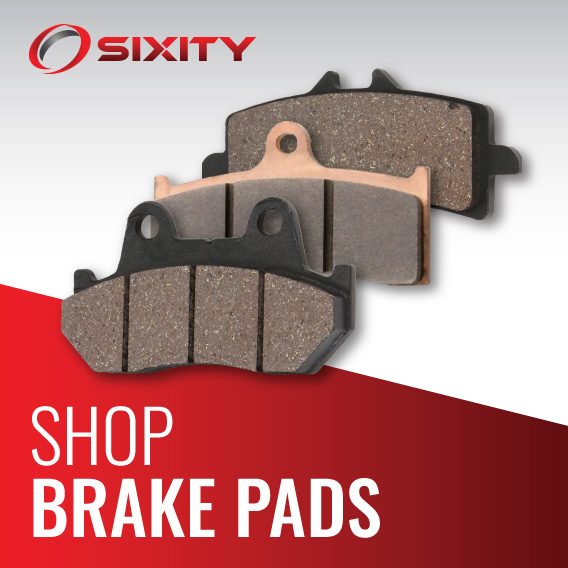How To Replace and Install Motorcycle Brake Pads
WHEN TO REPLACE YOUR MOTORCYCLE BRAKE PADS
Regular checks of brake pad wear is a good habit to develop, both for safety and to avoid unnecessary damage and repairs. Front pads tend to wear out faster than back pads, and if you have an aggressive style of riding check your brake pads more often.
The most accurate check is to remove and measure the brake pad. If pad thickness is less than 3 mm (1/8 inch), it's time to change the pad. If any backing plate metal shows through a pad, brake pad replacement is overdue and the brake rotor should be checked for damage.
As always, be sure to check the service manual for specific maintenance information.
ASSOCIATED TASKS
While the brake pads are removed, consider checking the quality and quantity of brake fluid, bleeding and replacing the brake fluid, and replacing the brake rotor.
THINGS YOU'LL NEED:
- Maintenance work stand
- Shop towels
- Wrench—for caliper mounting bolts
- Large flathead screwdriver
- Ruler—millimeters or inches
- Needle-nose pliers
- Brake cleaner
- Torque wrench—for caliper mounting bolts
REMOVE BRAKE PADS
- Stabilize the motorcycle with a maintenance stand per manufacturer's recommendation.
- Clean the exterior of the brake fluid reservoir and the reservoir cap. CAUTION: Remove the brake fluid reservoir cap to avoid excess pressure and damage to the master cylinder seals.
- Remove the brake fluid reservoir cap. Tie an absorbent cloth around the reservoir opening to absorb brake fluid spills. Secure a clean cloth over the reservoir opening to prevent contamination. CAUTION: Do not allow the caliper to fall or hang loose after removing the mounting bolts. Provide support to avoid damage to surrounding exterior finishes.
- Remove the caliper mounting bolts from the rotor.
- Push the pistons into the caliper to reset: NOTE: Watch the brake fluid reservoir while performing steps a and b to prevent fluid overflow. Carefully wedge a large flathead screwdriver between the old pads.
Slowly move the screwdriver up and down (to increase distance between the pads) to fully reset the pistons. - Slide out the retainer pin that holds the brake pads in place with needle-nose pliers.
- If applicable, remove the retainer spring plate laying on top of the pads.
- Remove the brake pads from the caliper.
- If applicable, remove shims from the back of the old brake pads (used to reduce braking noise). Save the shims for installation of new pads.
INSPECT BRAKE PADS
The entire surface of the brake pad should be parallel with the caliper surface. If wear on the pads is uneven or one pad has more wear than the other, it may be time to replace the caliper. Uneven wear can also be caused by corrosion or other residue on the retainer pin.
- Inspect the brake pads for wear. Make sure the entire surface of the pad is parallel with the caliper mounting surface. If the pads are not parallel, replace the pads.
Remove the brake pads from the caliper and measure the pad width. If a pad's width measures less than 3 mm (1/8 inch), replace the pads. CAUTION: Use only brake cleaner to clean caliper parts. Other cleansers may leave oily residue on the brake pad surface that can affect brake function. - Use brake cleaner to clean the caliper, including the area around the caliper piston's seal.
- If applicable, clean shims with brake cleaner.
INSTALL NEW BRAKE PADS
CAUTION: If shims are used, take care to only apply disk brake grease on the back of the new brake pads. Oily residue on the brake pad surface can affect brake function.
- If applicable, if shims are used and there are no clips to hold them in place, place a small amount of disk brake grease between the shim and the back of the pad to hold the shim in position while installing the pads.
- Place the new pads inside the caliper.
- If applicable, install the retainer spring plate.
- Install the retainer pin.
- Slide the caliper back onto the rotor. NOTE: If the caliper doesn't fit on the rotor, the pistons may not be fully compressed. Reinsert the old brake pads and refer to step 5 under "Remove Brake Pads."
- Install the caliper mounting bolts and torque the bolts to to the exact specification listed in the service manual.
- Pump the brakes several times to make sure they are in the proper position. CAUTION: Consult with the brake pad manufacturer for the "bed in" procedure that sets up proper brake function. Be especially careful while braking on the first ride after new pads are installed.
- Perform the bed in procedure per the brake pad manufacturer's instructions.
- End of Procedure -



